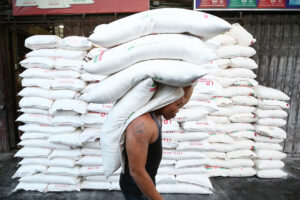By Chloe Mari A. Hufana, Reporter
THE Philippine government will expand its subsidized rice program to more provinces in the Visayas and Mindanao starting in July, as it expects long queues for the P20-per-kilo staple, the country’s top agriculture official said on Monday.
The second phase of the rollout will start in July and with phase three will follow in September, completing the program’s implementation across southern Philippines, Agriculture Secretary Francisco P. Tiu Laurel, Jr., told a news briefing at the presidential palace.
“[We will implement] three phases under what we call a shared subsidy,” he said in Filipino. “As for the Kadiwa program, there are 34 Kadiwa outlets serving the vulnerable sector. By next month, that number will increase to 55.”
The Department of Agriculture (DA) has sold more than 12,000 sacks of rice at P20 per kilo in Cebu alone, he said.
The first phase was implemented in Negros Oriental, Samar, Eastern Samar, Negros Occidental, Northern Samar, Leyte, Bohol, Antique, Cebu, Iloilo, Capiz, Biliran, Southern Leyte, Guimaras, Siquijor, Aklan and Mindoro.
The second phase will cover Zamboanga del Norte, Basilan, Cotabato City, Tawi-Tawi, Maguindanao del Sur, Maguindanao, Davao Oriental, Sorsogon and Maguindanao del Norte starting in July.
Phase three, beginning in September, will cover Sultan Kudarat, Lanao del Norte, Catanduanes, Agusan del Sur, Sarangani and Dinagat Islands.
These provinces have the highest poverty incidence, based on a 2023 report by the Philippine Statistics Authority (PSA) that the DA uses to determine priority areas for the program.
Mr. Tiu Laurel said they are working with newly elected local government officials to streamline distribution and ensure continued access to subsidized rice. The long-term goal is to institutionalize the program through 2028, he added.
“What we’re discussing now is just the formula; we already have an idea of how much it will cost, but the hardest part to determine is that this can’t be for all Filipinos,” he said in Filipino. “Naturally, the rich shouldn’t be included in this kind of program.”
“In general, the idea is to serve around 15 million families,” he said. “If each family has five or four members, that’s about 60 million people. The quantity per month is still being determined.”
Despite recent declines in food inflation, affordability remains a concern for many Filipinos. Food inflation at the national level eased to 0.7% in April 2025 from 2.3% in March and 6.3% a year earlier, according to the PSA.
The slowdown was mainly driven by a sharper year-on-year decline in the rice index, which dropped 10.9% in April compared with a 7.7% decrease a month earlier.
President Ferdinand R. Marcos, Jr., made the P20-per-kilo rice a centerpiece of his 2022 presidential campaign, aiming to reduce the cost of the country’s staple food through subsidies, improved local production and more efficient distribution.
The program, implemented through the DA and Kadiwa initiative, seeks to make affordable rice available to low-income families while stimulating agricultural productivity.
